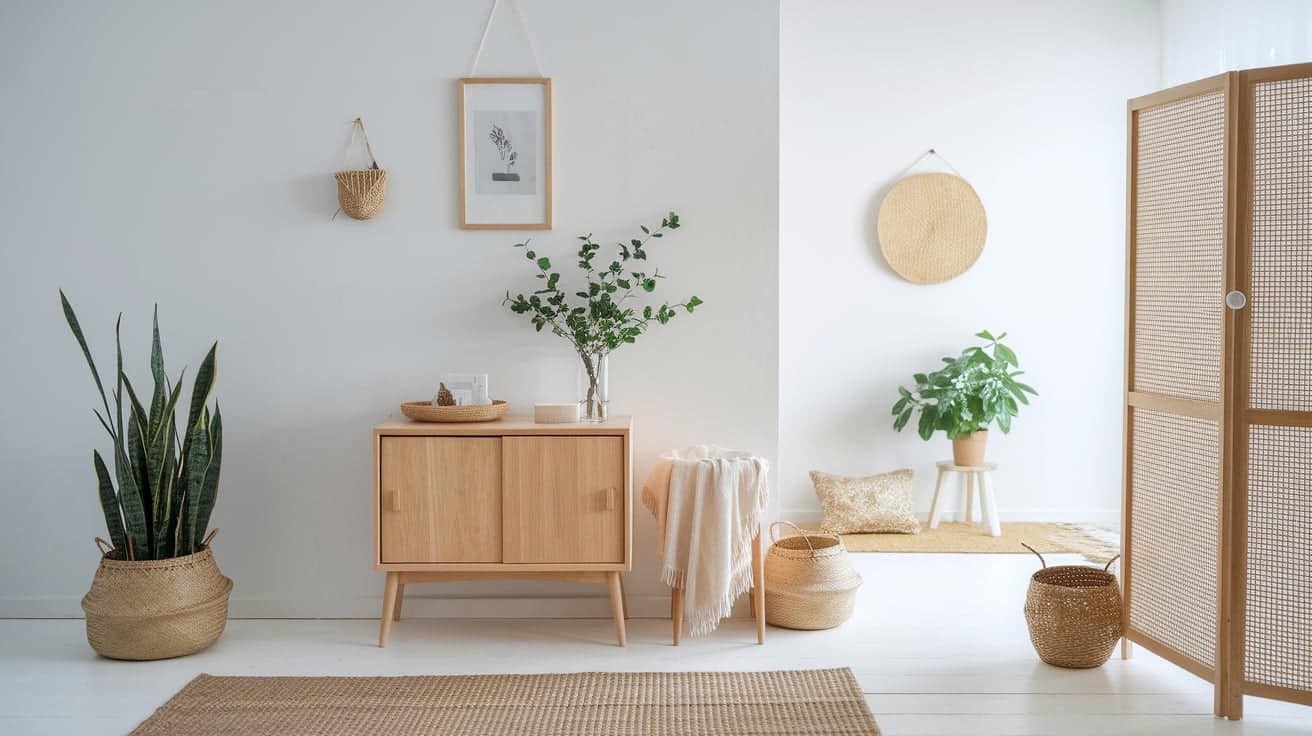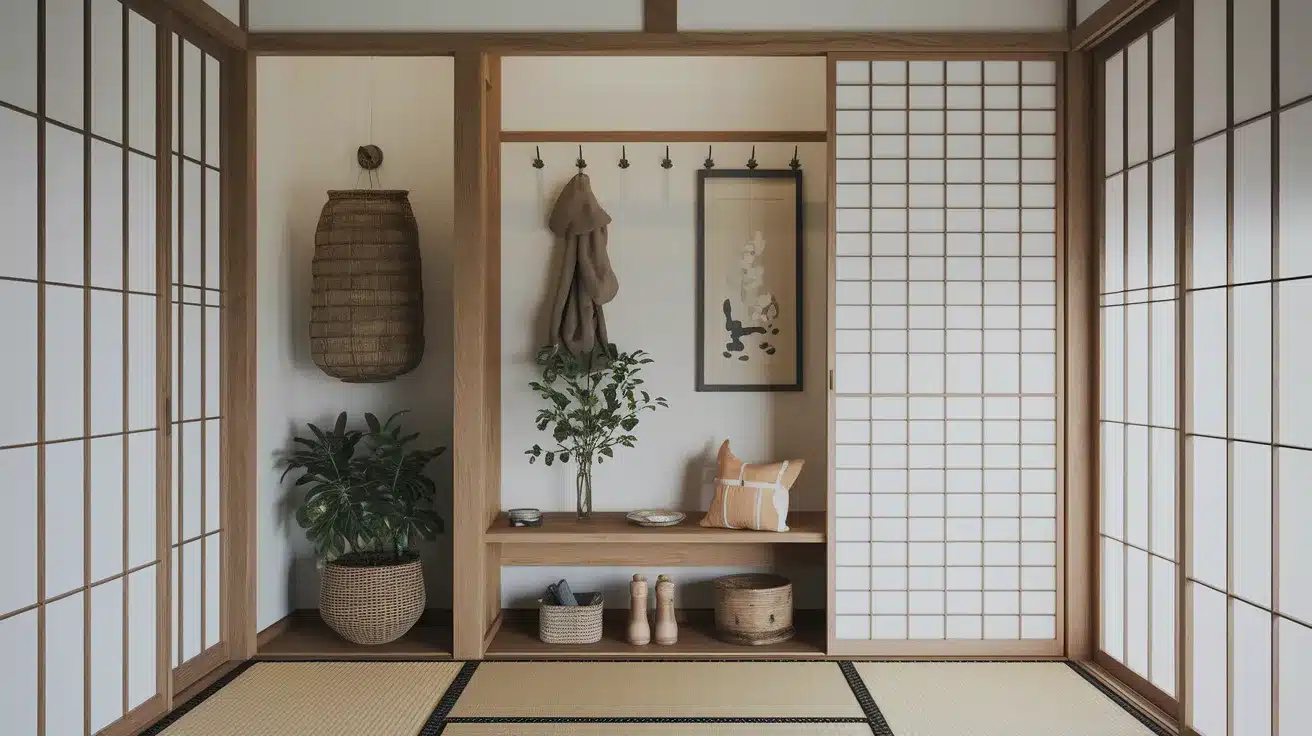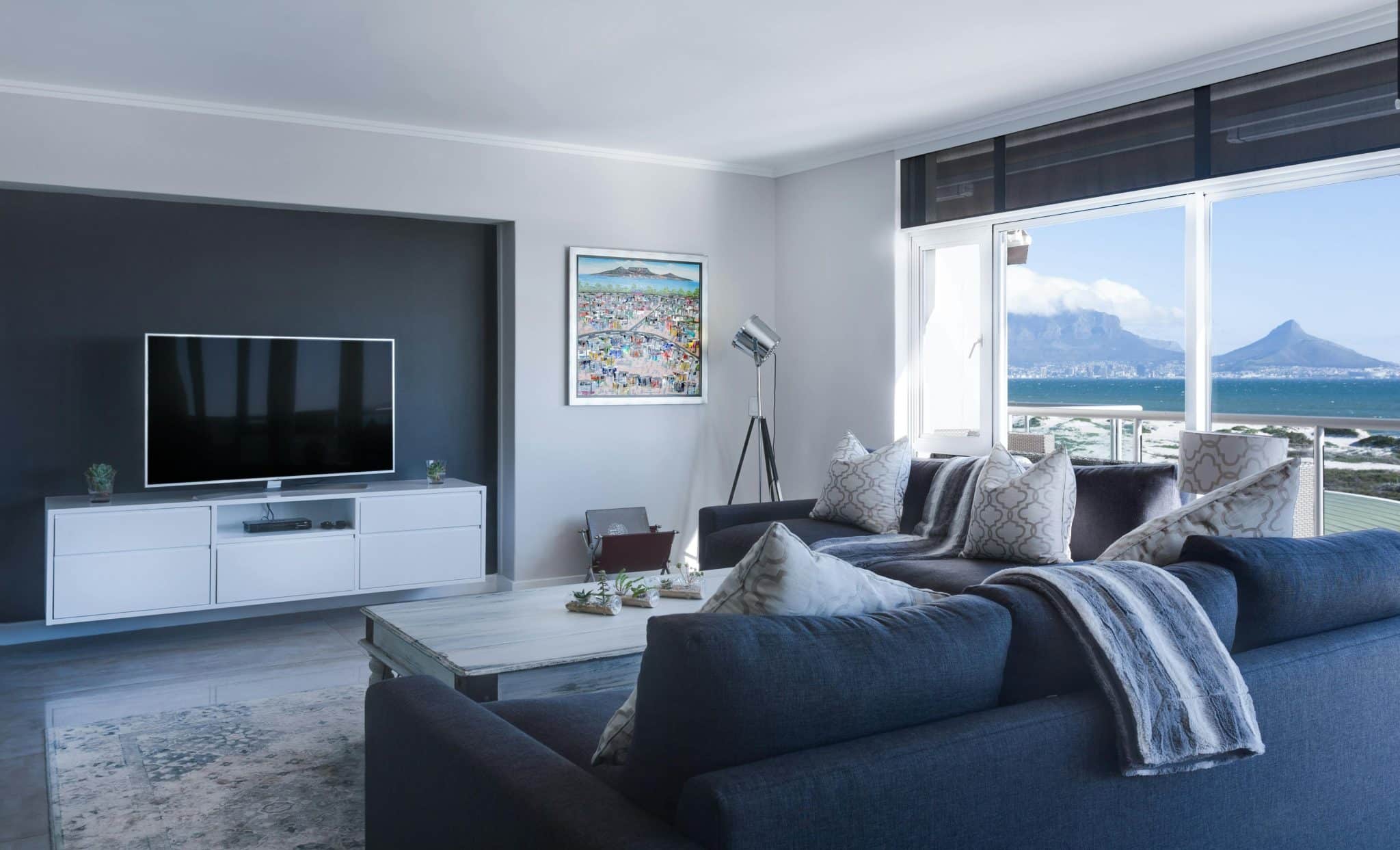Stepping into a Japandi entryway feels like taking a deep breath of fresh air after a hectic day.
I’ve always been drawn to this perfect marriage of Japanese minimalism and Scandinavian coziness, where clean lines meet warm textures and simplicity embraces comfort.
After redesigning my home entrance, I found that this style creates not just a beautiful space, but a mindful transition between the outside world and your personal sanctuary.
The beauty of Japandi lies in its thoughtful restraint: keeping only what matters and letting each element shine.
Ready to convert your entryway into a serene haven? Let’s study these 37 ideas together.
Japandi Entryway Ideas You Can Try!
Japandi design mixes Japanese simplicity with Nordic comfort, creating spaces that feel both minimal and cozy—ideal for your home’s first impression.
1. Adopt Natural Materials

Genuine Japandi entryways are based on wood, bamboo, and stone. Their natural textures add depth and character while remaining timeless and grounded.
Add these elements in flooring, wall panels, or furniture pieces to form a connection with nature that defines this balanced style.
2. Choose a Neutral Color Palette
Soft beiges, gentle grays, warm off-whites, and light wood tones make a serene base. These understated hues build a peaceful backdrop that promotes calm while allowing natural materials and thoughtful design elements to become the focal points.
The simple palette helps maintain visual unity throughout the space.
3. Keep Furniture Simple and Functional
Select furniture with clean lines that serve clear purposes. A minimal bench for removing shoes, a simple console table for keys and mail, or storage cabinets with hidden compartments maintain order.
Choose pieces that solve everyday needs without extra details, following the “less is more” approach.
4. Add Greenery with Indoor Plants
Put plants in careful spots to bring life and energy to your entryway. Bonsai trees offer small natural forms, while ferns add fine texture. Sturdy succulents need little care yet add strong shapes.
Pick simple, natural containers that work with wood elements rather than fighting for attention.
5. Opt for Clean, Sleek Lines in Furniture
Pick furniture with plain, simple shapes that skip fancy details or excess decor. Look for pieces where shape follows use – straight edges, few joints, and smooth surfaces.
This planned simplicity builds visual unity while letting the natural beauty of materials stand out the most.
6. Maximize Natural Light
Keep windows clear or use sheer curtains that filter light gently. Put mirrors in smart spots to bounce and boost available sunshine. Pick light-colored surfaces that reflect light through the space.
Natural light brings out wood tones and builds an open, airy feeling central to the Japandi style.
7. Use Subtle Lighting Fixtures
Put in warm, soft lighting that adds mood without standing out too much. Paper lanterns spread gentle light while simple hanging lights give focused brightness.
Wall lights with a mild glow work without harsh spots. Choose fixtures with natural materials or clean design that fit with the room rather than drawing too much notice.
8. Incorporate Japanese-Inspired Decor
Add items like shoji screens for room dividing, simple wooden objects for art touches, or tatami-like textures for genuine feel. Choose things that hint at Japanese design without seeming like obvious imports.
The goal is subtle cultural nods that mix well with Scandinavian simplicity for balanced unity.
9. Keep the Space Uncluttered
Be strict about what stays by keeping only what has purpose or brings joy. Remove items that don’t truly help the space. Leave room between things rather than filling every spot.
This careful holding back makes a sense of openness and calm that soothes you right when you walk in.
10. Utilize Hidden Storage Solutions
Use smart options that keep daily items handy yet out of sight. Built-in cabinets with simple hardware, benches with hidden spots, or thin wall-mounted holders keep visual calm.
Think about furniture that works two ways—storage seats, entry tables with drawers—to make the most of function without adding visual bulk.
11. Add Textures with Rugs and Mats
Put natural fiber floor coverings down to bring warmth and touch comfort. Wool rugs with simple patterns, jute mats with raw texture, or bamboo runners add depth while guarding floors.
Pick quiet tones and natural materials that go well with wooden parts while softening hard surfaces.
12. Play with Symmetry in Design
Make visual balance through careful, planned placing. Put matching wall lights on both sides of a mirror, line up furniture with room lines, or balance a table with well-placed items on top.
This neat approach builds a sense of order and calm that looks planned rather than random.
13. Focus on Simple Art Pieces
Pick artwork that shows calm through holding back. Black and white nature photos, simple ink drawings, or basic pieces with few colors add visual interest without too much busy-ness.
Choose frames with clean lines in natural materials. Limit to one or two good pieces rather than many small ones.
14. Integrate Soft, Cozy Textiles
Mix sharp building lines with touches of softness. A linen pillow on a wooden bench, a small wool throw laid casually, or a woven wall hanging adds warmth and welcome.
Pick natural fibers in quiet colors that work with rather than pull focus from the plain base.
15. Choose Natural Fiber Mats or Baskets
Add woven items that work for both use and looks. Seagrass baskets hold shoes or scarves, jute mats mark the entry space, and bamboo holders keep small things tidy.
These items with texture bring natural warmth and handy fixes while staying with the natural material theme needed for real Japandi style.
16. Utilize Japanese Sliding Doors
Put in space-saving doors that hint at shoji design while meeting modern needs. Sliding panels with misty glass or natural wood frames make smooth moves between areas.
These building parts save floor space while adding a true feel that honors Japanese design history without looking like a copy.
17. Incorporate Wooden or Bamboo Walls
Add depth with natural wall coverings that build visual warmth. Upright wood strips, side-to-side bamboo panels, or part accent walls bring a natural feel without too much business.
These parts make a nice-looking setting that seems thought-out rather than just thrown together, rooting the space with a natural look.
18. Opt for a Simple Mirror Design
Hang a mirror with clean, plain framing in natural wood or basic metal. Put it where it will catch light and make the space seem bigger.
Choose a size that fits your wall without taking over. Good mirrors work three ways: quick look checks, space-growing tricks, and subtle room style.
19. Add Simple, Minimalist Shelving
Put up wall shelves with clean, straight lines and little visible hardware. Show only a few chosen items—maybe a small clay pot, a special stone, or a daily needs set with care.
Leave plenty of empty space around things so each piece can be seen and liked on its own.
20. Choose a Japanese-Inspired Entryway Door
Pick a front door that shows your style right away. Try natural wood with simple details, clean-lined panels, or basic pattern work.
Think about doors with cloudy glass parts that hint at shoji screens while letting soft light through. This first thing guests see sets up what they’ll find in your well-planned home.
21. Invest in Minimalist Door Hardware
Pick hardware with quiet good looks that feels nice to touch daily. Thin handles, simple knobs, and modest hinges in matte black, brushed nickel or warm brass add refined small details.
Look for pieces that work smoothly and use good materials that get better with age rather than worse.
22. Layer with Textured Fabrics
Add subtle cloth types to bring touch richness without looking busy. A plain linen curtain softening light, a rough wool wall piece, or a raw silk pillow brings depth against clean room lines.
Pick natural fibers with clear texture rather than bold patterns for real Japandi balance.
23. Consider a Japanese-Style Entry Bench
Place a low wooden bench with clean lines near your door for both use and looks. The simple shape gives comfy seating while taking off shoes, and the low height nods to Japanese furniture sizing.
Pick solid wood building with few joints that show good work rather than fancy trim.
24. Incorporate Low Lighting Fixtures
Pick lighting that works without drawing too much notice. Lights set into ceilings, thin track lighting, or low-set wall lights light up the space while keeping clean room lines.
Think about aiming options that show off wall feel or art pieces without making harsh bright spots from above.
25. Introduce Zen Elements
Add quiet touches that bring thoughtful calm. A small stone group with changing feels, a table-top water bowl with soft sounds, or a tiny raked sand tray with pattern lines bring thinking quality to your entry.
These items help you pause and be present when coming in or going out.
26. Use Traditional Japanese Tatami Mats
Consider incorporating tatami-inspired floor coverings for the original character. These woven straw mats provide comfortable resilience underfoot while connecting to centuries of Japanese design heritage.
Modern versions offer durability while maintaining the distinctive texture and subtle scent that add sensory dimension to your entryway experience.
27. Combine Scandinavian and Japanese Elements
Mix Nordic warmth with Japanese plainness through careful pairing. A curved Danish-style bench next to a straight-lined Japanese cabinet makes good visual mix.
Light wood shades with darker bits bridge these matching looks. Wool cloths beside bamboo parts blend cultures while keeping matching material unity.
28. Feature a Statement Piece with a Minimalist Design
Include one carefully chosen main item among your few things. A simple hanging light with a paper shade, a well-built bench with clear joining work, or a single stand-out clay pot makes a main point without being too much.
This key piece should work for both looks and use while keeping plain style rules.
29. Introduce Japanese Lanterns
Hang paper or wooden lights for a soft, all-around glow with cultural roots. These old-style lighting items cast warm, soft light that makes the space feel good.
New takes keep the main idea while fitting today’s homes. Place objects at different heights for look rhythm without breaking the overall plain feeling.
30. Install Sliding or Folding Entryway Doors
Try space-smart door fixes like pocket sliders or folding panels that make the most of room. These systems let you split rooms without needing swing space that normal doors take up.
Pick natural wood looks or simple metal parts that focus on clean motion and building strength over fancy bits.
31. Incorporate Wooden Slats or Panels
Add building interest through evenly spaced wood parts that play with light and dark. Up-down slats let views through while keeping some privacy, side-to-side panels make calm feel, and shape-based screens mark areas without solid walls.
These parts add a pattern through building ways rather than add-ons, fitting Japandi ideas.
32. Use Stone or Concrete Elements
Bring in earthy, solid materials as careful extras that balance lighter parts. A concrete plant pot holding simple greenery, a carved stone dish catching keys, or a pebble row beneath a bench brings a rock-like feel indoors.
These items give nice weight and touch change from wooden parts.
33. Add a Zen Water Feature
Consider a modest water element that engages multiple senses. A small stone fountain with gentle trickling sounds, a bamboo spout filling a ceramic basin, or a simple bowl with floating candles creates immediate calm.
The combination of sound, movement, and reflection adds living energy to the otherwise still space.
34. Choose Neutral, Calm Flooring
Pick flooring that builds a quiet base through natural stuff and soft colors. Wide-board light oak, non-shiny stone tiles in soft gray, or plain clay surfaces give rooting energy.
Skip high-shine finishes or busy patterns that upset the visual quiet needed for Japandi room balance.
35. Integrate Wooden Tones with Textured Decor
Match warm woods with fitting textures to build depth without mess. Put smooth wooden chairs with rough clay pots, flat timber tops with woven baskets, or even floors with bumpy cloths.
This careful mixing of touch-nice things adds richness while keeping the quiet color range needed for Japandi unity.
36. Include Subtle Japanese-Style Prints
Add small patterns with cultural roots through light touches. A single pillow with wave marks, a small framed blue cloth with a shape pattern, or a clay piece with old-style glaze methods adds interest without taking over. Keep these bits as small notes rather than main parts.
For refined contrast. Brass hooks, copper details, or brushed steel fixtures add sophisticated highlights while maintaining the overall natural, earthy palette of your Japandi space.
Common Mistakes to Avoid
- Adding too many items – each piece should serve a purpose and have room to “breathe.”
- Mixing too many wood tones – stick to 2-3 compatible wood types for a cohesive look.
- Using bright, shocking colors instead of natural, muted earth tones
- Overstyling with purely ornamental objects that lack function
- Ignoring proper scale – furniture that’s too large or too small disrupts balance
- Forgetting negative space – empty areas are essential to the calm Japandi feel
Tips on Maintenance
- Dust wooden items weekly with a soft, dry cloth and apply food-grade oil twice yearly
- Clean bamboo with barely damp cloth only – never soak
- Use pH-neutral cleaners on stone surfaces – avoid acidic products
- Rotate natural fiber rugs seasonally and gently shake weekly instead of vacuuming
- Keep shoes at the door to prevent dirt from entering and maintain clean floors
- Allow some aging signs to remain – minor wear adds character to natural materials
Conclusion
Making a Japandi entryway isn’t about hard rules—it’s about finding the balance between use and looks.
Through these 37 ideas, I’ve seen that the real magic comes when plainness meets purpose.
Your entryway tells others who you are and what matters in your home.
By using natural materials, clean lines, and quiet bits, you create a space that welcomes guests and helps you move between the busy outside world and your own space.
Comment below which idea you are going to incorporate in your home?











































